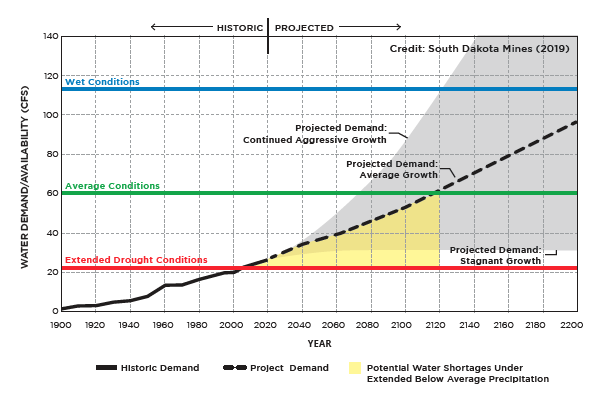Water Supply Challenges Loom
- Western South Dakota’s existing water supply will not be adequate due to population growth and fluctuations in supply caused by drought conditions
- Conservation can help manage future demand, but it is not the whole solution to the water supply challenge
Current Demand Exceeds Water Availability During Drought

As the population in western South Dakota grows, the existing water supply will not be adequate. Increasing demand and fluctuations in available supply due to drought conditions pose a challenge.
Management of future demand through Conservation is part of the solution, but not the whole solution.
Notable Findings – Rapid City Housing Market Study, January 9, 2023
- Population Change over the last decade = 15%
- Projected Population Increase 2020 to 2030: 18.9%
(Prepared by MSA Professional Services, Inc, for the Rapid City Strategic Housing Coalition, a partnership between Elevate Rapid City, the City of Rapid City, The Black Hills Area Community Foundation and the John T. Vucurevich Foundation. The study was commissioned to better understand Rapid City’s housing marketand the housing market in surrounding communities (Spearfish, Box Elder, Summerset, Piedmont, Sturgis, Rapid Valley, Colonial Pine Hills, Black Hawk and Ellsworth Air Force Base–the secondary market.)

Water Use: Gallons per
Capita per Day (GPCD)
Range of water use per person by system size
• ≥200 Connections: 111 to 283 GPD
• <200 Connections: 74 to 153 GPD
~110-130 GPCD
OVERALL AVERAGE
Conservation

The US Geological Survey estimated water use in South Dakota in 2015 at 51 to 75 gpcd SD Mines Study (2019) estimated current water supply in Pennington
County at 22 cubic feet per second (cfs) under extended drought conditions. At the current population in Pennington County, that equates to 107 gpcd. The graphic to the right projects how per capita water use associated with 22 cfs of available supply changes as the population grows.
